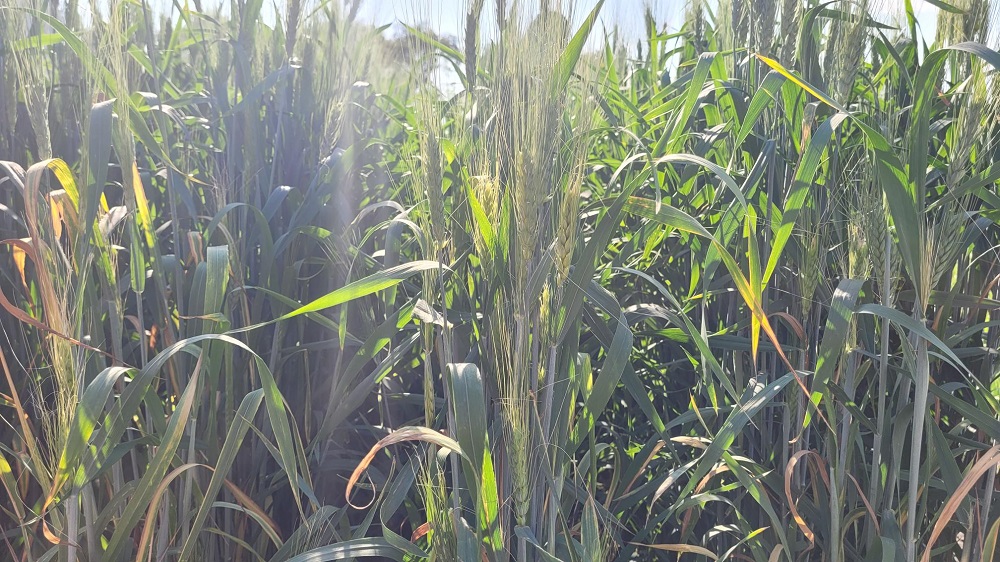Harvest in Saskatchewan is close to 100 percent as it can be.
The Saskatchewan Crop Report, released today (Thurs), has harvest at 95 percent complete, slightly up from 91 percent the previous week, but still ahead of the 5-year average of 84 percent.
Other than the odd field, producers in the west-central and southwest are done for the year while others are getting close. Farmers in the northwest and southeast are 93 percent complete, the northeast 92 percent, and the east-central 90 percent.
Provincial Cereal Specialist Matthew Struthers says canola and flax are crops left to be combined, but completing them have been delayed due damp weather this past week. Producers are also hoping frost can stop the regrowth of flax which has been occuring due to rain.
“Some rainy days, some high humidity days…really slowed down progress; pushed most operations to start in the afternoon so it limited the amount of crop coming off,” Struthers said.
There were some showers in every region, including a few large ones ranging from 30 to 45 mm. Struthers says this slightly increased topsoil moisture levels.
Cropland topsoil moisture is rated as 23 percent adequate, 52 percent short and 25 percent very short. Hay and pasture land topsoil moisture is rated as 19 percent adequate, 53 percent short and 28 percent very short.
Reports of crop damage suggest waterfowl, wildlife, and wind were factors, especially the wind which Struthers says blew swaths around, as well as shelling out crops and causing lodging.
Crop reporters also recorded the quality of hard red spring wheat: 57 percent of the crop received a 1CW grade, 37 percent 2CW and seven percent 3CW. While these initial grades are lower than in recent years, they remain above the 10-year average.
The 10-year average for Hard Red Spring Wheat is 43 percent 1CW, 32 percent 2CW, 16 percent 3CW and nine per cent 4CW/feed.
This is the last Crop Report before the final one is released on October 20th, which Struthers says gives them more time to gather information.
A region-by-region breakdown is below.
Southeast
Harvest progress was slowed this week due to rain and heavy dew mornings. Producers in the region have 93 per cent of their crop in the bin, this is right in line with the five-year average. Producers are hoping that the weather begins to dry up and allow them to finish harvest without any more delays due to moisture, as it could result in lower grain quality.
There was a wide range precipitation received in the region this week with the Broadview area receiving the most at 45 mm while areas like Stoughton only received five mm. Producers are happy to see the rain and would like more to come before freeze up.
Hard Red Spring Wheat was graded as 56 per cent 1CW, 33 per cent 2CW and 11 per cent 3CW. Most of the downgrading was due to bleaching or disease related issues.
Cropland topsoil moisture is rated as 29 per cent adequate, 42 per cent short and 29 per cent very short. Hay and pasture land topsoil moisture is rated as 29 per cent adequate, 44 per cent short and 28 per cent very short.
The majority of crop damage this week was due to strong winds, wildlife and hail. Wind has continued to blow around swaths and damage seed heads resulting in lost yield. The recent rain has also led to grain sprouting in both swathed and standing cereal crops, especially barley. A hail storm passed through Crop District 1B resulted in severe damage with some producers seeing 100 per cent loss of their remaining crop.
Producers are busy harvesting, starting fall field work such as weed control, harrowing, hauling bales, cleaning corrals and moving cattle to stubble fields.
Southwest
Harvest is mostly wrapped up in the southwest with mainly flax being the last crop left to be combined. Producers are waiting for a hard frost, as it will stop any regrowth and force the crop to mature. Producers would like to see a large general rain sweep across the region over the course of a couple days to allow the soil moisture to be recharged and to see their pastures green up before winter.
Grain quality for Hard Red Spring Wheat was rated as 43 per cent 1CW, 44 per cent 2CW and 13 per cent 3CW. Grain quality suffered this year due to excessively dry and hot growing conditions.
There were widespread rain showers in the region last week. Several areas received 10 to 25 mm while the Tyner and Shaunavon areas saw nearly 40 mm. This rain was highly appreciated by producers and is a start to replenishing the large moisture deficit the region is in.
Cropland topsoil moisture is now rated as eleven per cent adequate, 56 per cent short and 33 per cent very short. Hay and pasture land topsoil moisture is rated as 11 per cent adequate, 55 per cent short and 34 per cent very short. Some producers do not expect they will have enough feed to last the winter with their current herd sizes and are considering reducing their numbers.
Producers are busy wrapping up harvest, harrowing, hauling bales, cleaning corrals and moving cattle to where they can be fed and watered.
East-Central
Harvest conditions were acceptable across the region until cool damp weather coming into the weekend slowed or halted producers. The region has 90 per cent of their crop in the bin, which is ahead of the five-year average of 82 per cent. Most producers only have canola left to be harvested. Producers are predicting that harvest will be wrapped up in about a week to ten days as long as the weather holds out and no rainfall is received.
Precipitation in the region was mostly contained in the southern and western halves of the region, the Esterhazy area received a range of rainfall from 26 mm to 40 mm while other parts of the region only received four to 13 mm.
Cropland topsoil moisture is rated as 42 per cent adequate, 41 per cent short and 17 per cent very short. Hay and pasture land topsoil moisture is rated as 33 per cent adequate, 45 per cent short and 22 per cent very short.
More frequent rainfall throughout the summer has resulted in Hard Red Spring Wheat grades to be reported as 57 per cent 1CW, 38 per cent 2CW, four per cent 3CW and one per cent 4CW/feed.
The majority of crop damage this week was due to wind, waterfowl and rain. Some of the crop is coming off tough and being placed into aeration bins or grain dryers. There were reports of hail but no damage assessment has been provided at this time.
Producers are busy combining, harrowing, hauling grain, hauling bales and applying post-harvest herbicides.
West-Central
Harvest is virtually wrapped up, but there are a few acres of canola or flax still to be combined once the weather improves. Producers who have finished up are now moving into other field work before the snow falls.
Producers received widespread rains this past week, these rains will be very beneficial for the soils, pastures and dugouts across the region. Most of the rainfall in the region ranged from 15 to 30 mm with the lowest amounts received being eight mm. Moisture conditions in the region were desperate all summer long and producers hope for more rain soon.
Cropland topsoil moisture is rated as 18 per cent adequate, 59 per cent short and 23 per cent very short. Hay and pasture land topsoil moisture is rated as eleven per cent adequate, 58 per cent short and 31 per cent very short.
Quality for Hard Red Spring Wheat was rated as 72 per cent 1CW, 24 per cent 2CW, and one per cent 3CW.
There was not much crop damage this week due to most of the crop being harvested already. Producers are busy finishing up combining, harrowing, and hauling grain or bales and many more postharvest activities.
Northeast
Harvest is well ahead in this region, at 92 per cent complete, due to many factors, mainly a much earlier completion of seeding than normal and another dry hot summer forcing crops to mature quickly. Producers are finding their yields are better than expected at the start of harvest.
Like the rest of the province, precipitation was received and while it slowed harvest progress it is also beneficial for the topsoil moisture. Cropland topsoil moisture is rated as 77 per cent adequate and 23 per cent short. Hay and pasture land topsoil moisture is rated as 77 per cent adequate and 23 per cent short.
Due to rainfall throughout August and early September, the region is seeing a lower amount of spring wheat being graded as 1CW. Quality ratings for Hard Red Spring Wheat has been reported as 34 per cent 1CW, 60 per cent 2CW and 10 per cent 3CW.
The majority of crop damage this week was due to wind blowing around swaths, waterfowl and wildlife. Producers are busy combining, harrowing, spraying weeds, baling and hauling bales.
Northwest
With 93 per cent of the crop in the bin, producers are nearing the end of the 2023 crop season. A dry spring allowed producers to finish up seeding much earlier than normal has also allowed harvest to be completed at an accelerated pace. However, not much crop was harvested in the past week due to rainy, cool weather making the crop tough and damp.
A wide range of precipitation was reported this past week. Most of the rain received was between ten mm to 20 mm. Cropland topsoil moisture is rated as 44 per cent adequate, 40 per cent short and 16 per cent very short. Hay and pasture land topsoil moisture is rated as 39 per cent adequate, 41 per cent short and 20 per cent very short.
Hard Red Spring Wheat is rated as 65 per cent 1CW, 33 per cent 2CW and two per cent 3CW. Grain quality remains very high in the region, even though precipitation has been higher than other regions in the last portion of the growing season.
The majority of crop damage this week was due to wind, wildlife and waterfowl. Wind has been blowing swaths around but has also helped to dry some of the crop in the field. Producers are busy combining, drying grain and moving bales.








